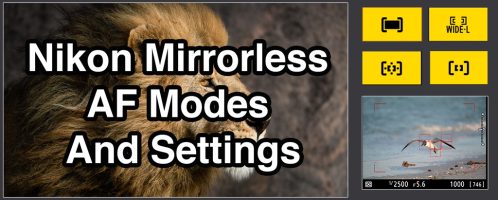Try a better way to focus your DSLR! Using back button autofocus is a faster, easier, smarter way to get great AF results from your DSLR. This video will show you how AF modes work – and why decoupling autofocus from your shutter release can take your photography to a whole new level.
This method works both for a camera with a dedicated AF-ON button or by reassigning a button on the back of your camera for autofocus.
Follow Up Notes and FAQ
This turned out to be a really popular topic and I’ve had quite a few questions come in regarding this technique. So, I’ve put together some notes and a few commonly asked questions that should make the transition from shutter release AF to back button AF much easier.
Q:
When I try this technique on my Nikon, I focus and recompose, but my camera won’t fire. The only way I can get the camera to take a picture is if the AF point is right over the spot that I focused on.
A:
This behavior occurs when the camera is set to “Focus Priority” for AF-C under the custom functions menu. By default, most cameras will use what’s called “Release Priority” when they are switched to AF-C mode, so most users will not run into this issue.
However, sometimes a camera is set to “Focus Priority”, meaning the camera will ONLY fire if it has a 100% focus lock under the current AF point. This behavior is fine when you’re locking in focus with the shutter release or you happen to have the AF point right smack dab on the area where you want to focus. However, with Back Button AF it causes an issue since you can no longer focus, recompose, and shoot (the AF point may no longer be over an area that’s in sharp focus).
So, make sure your AF-C focus Priority is set to “Release” under your custom menu. Usually, it’s the first option for most Nikon cameras.
Q:
With shutter button AF, my VR was activated when I pressed partway down on the shutter release to focus. When I use the back button, VR no longer activates when I focus. How do I handle this?
A:
The answer to this is going to depend on your camera. If you have a newer Nikon body (like a D800 / D4 etc), using the back AF-On button will actually activate VR. For older cameras, it’s only activated with a half-press of the shutter release.
However, don’t let that stop you!
I used this method a long time before it was linked with the shutter AF-On button on the back of the camera. In fact, I prefer VR to be available with a half press (it still is with newer cameras, it’s just been added to the AF-On button).
The reason I prefer it with a half-press of the shutter release is that I can keep VR active before the action starts. This is critical since VR needs a few seconds to stabilize before you start shooting. If you simply focus and shoot at the same instant – before VF has had a chance to stabilize – you’ve lost all the benefit of using it. So, use your back button to AF, and hold halfway down on the shutter release until and wait for that perfect moment. Then, just a little extra presser from your finger snaps the shot.
Q:
What about using dynamic AF? Like d9, d21, or 3d tracking?
A:
No worries – it works exactly the same as if you were using your shutter release for AF. The next question is why / how to use those dynamic AF tracking modes, but that’ll be another video. (hint – most people should probably start with 21pt)
Q:
My camera used to beep for focus confirmation, now it’s not doing it – what happened?
A:
Unfortunately, this is one downside of this method, you’ll no longer get that focus confirmation beep. However, I’ve learned to keep an eye on the AF confirmation dot in the viewfinder and have never really missed the beep. Besides, for the most part, you can see if the subject is in focus or not right in the viewfinder. Old school style 🙂
Q:
Do you always focus with just the center AF point and recompose?
A:
Nope, I did it that way for the video to keep things nice and simple, but most of the time my recommendation is to select the AF point that the closest to the spot you’d like to focus on. Sometimes you get lucky and you’re able to put the AF point right over the area you want to focus on, other times you’ll need to recompose, but at least it’s a minimal amount. Either way, this method has worked great for me.
Q:
Are there any limitations when using flash units?
A:
Under normal circumstances, no, this works just like shutter release AF. However, this is one exception to the rule and that’s if you use the AF Assist Illumination feature – this method doesn’t support it (at least with Nikon).
Q:
Why do all these questions seem to involve Nikon cameras? What about Canon?
A:
Unfortunately, I don’t own any Canon cameras at this time, so I can only speak to what I know about the Nikon and encourage Canon users to apply the concepts to their cameras. I do plan on getting a Canon body down the road for instructional purposes.
PS…
If you enjoyed this article, I think you’ll REALLY like my e-books, Secrets To Stunning Wildlife Photography and Secrets To The Nikon Autofocus System. They’re filled with hundreds of pages of information just like this. Check it out – click here (hey, it’s free to look 🙂 )




I just finished setting this up on my D810 and D850 today. I am curious about your tripod and especially the tripod head you used for this video. I have been looking at the Really Right Stuff head for a while now. Expensive but they seem easier to use than the Manfrotto I am currently using. Is it worth the money?
May I suggest an alternative? Look for internet reviews on Leofoto tripods and heads. They have been compared to RRS in quality and versatility without the cost. I used to use Manfrotto too. Used to, before I discovered Leofoto.
I checked them out and found the parent company owned by China. Not sure what that means but RRS is American made. I am willing to pay more for American jobs and products when I can. Thanks for your reply.
Fair enough. I’m Canadian so I’m more flexible with my choices and that includes my old Manfrotto which is made in Italy, not the US anyway.
I seem to have given you a wrong impression and for that I apologize. I have five Manfrottos, one Silk and an old Hansa for tripods. The Hansa from circa 1967.
I purchased some of your e-books, and loved every one of them. Thanks for making them. I followed your instructions for setting up BBF. I love it. I am trying to set the camera back to AFS, but all I can see is AFC. Does DDF prevent AFS from showing up?
This worked great until I handed my camera over to a self proclaimed professional. Forgot to mentioning to use the button on the back to focus. I now have a bunch of blurry photos of me. LOL.
Dear Steve, I have a query. Half pressing the shutter button, does two things — lock the focus and lock exposure as well. Through AF-ON, we take away the focusing function of shutter release. Should we then leave the exposure function on shutter as before? My camera is Nikon D5300 which allows that exposure determination can also be altered through the custom setting menu c1. Also, in my camera manual, it mentions that AF-on, best works when a4 (Rangefinder) option is enabled!! What is that? I would love to hear from you. Thnx and regards.
Hi, I have the Nikon Coolpix P900 and I do not have the AF-C mode, only has AF-S or AF-F mode. How do I set this up on my Nikon P900?
Thank you.
Still confused about whether to continually hold the bff button the entire time you are shooting a moving child or do you click BFF button, release and take the multiple shots?
with back button focus set on my Nikon d 810 is there a way I can set vertical grip button to focus?
thanks,
Marty
I have the D7200 .The question is : (which is the setting) By the use of AEL/AFL button how can I skip the half pressing of button in order to focus and only by pressing the button to take the photo.
hi..i just want to ask..im using this kind of technique but my question is do i need to meter fist before focusing or focus first before metering? and also every time i release the lock button to recompose the confirmation dot does not not appear even a very small movement..
RE comment above about not getting a ‘beep’ with rear AF-ON. It does beep with AF-ON but only if AF priority selection is set to ‘focus’ oinstead of just ‘release’
That is true for AF-S, but not for AF-C; and AF-C is how BBAF should be set. I just double-checked my cameras to be sure, and none of them beep in AF-C mode, even with Focus priority set.
Hi steve jb here from south-africa i have a qeustion i have a nikon D3200 because i am still a beginner now i watched your video on back button AF will it only work on AF-C or will it also work on AF-S or do you recommend using the shutter release button for AF-s
and as i progress can you please recommend which body i should move to next i personally like the d810 but what would you recommend to be the best one
thanks
Hi JB –
For BBAF to work as described in the video you need AF-C. Otherwise you lose the advantage of being able to instantly track. As for cameras, it really depends on what you shoot. For wildlife, I like the D500, but I can make a D7200, D750 or D810 work as well. For landscapes, I’d go D810 or D750.
Does this method have any negative effect on getting the correct exposure since I am going from AE/AF Lock to AF only?
In and of itself, the button used for AF doesn’t not have any effect on exposure. Of course, if you use AE Lock to lock in exposure, then it can since that option is no longer available. However, you can usually reassign AE-L to another button, like the Pv or Fn button. That way, you have the best of everything 🙂
Thank you for your lessons. I learned a lot from you. I just have another question to ask. How about the VR of third party lenses? (Like the VC of Tamron) Will it activate if I am using back button focusing just like the VR of nikon lenses? I’m using the newest model of nikon “D3400” i hope you can send me an answer.
Not too sure – I only have Nikon lenses with VR. I would assume they would active the same way the Nikon glass does though.